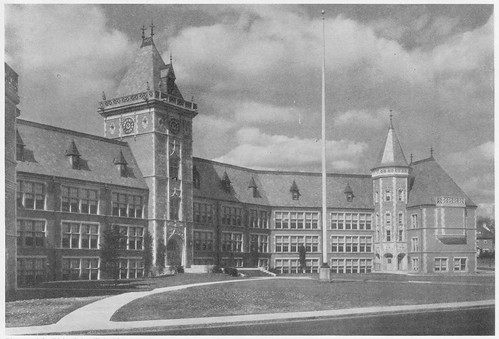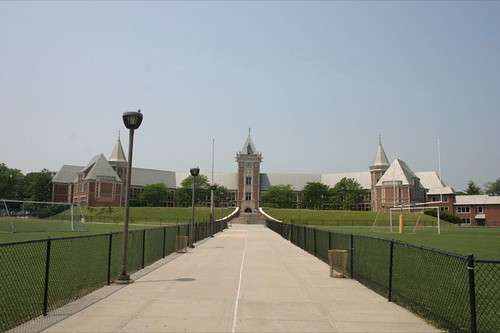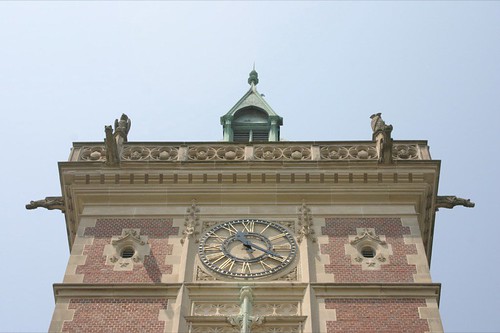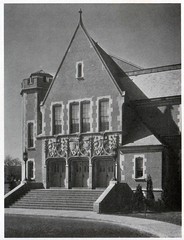
Referencing New Rochelle’s French heritage, New Rochelle High School was rendered in a French Gothic style infused with provincial chateau elements.
My first exposure to New Rochelle High School was a series of photographs in a 1932 article on school architecture written by James Betelle. While I had been pretty familiar with the traditional English Gothic and Neo-Classical designs of his schools, this one stood out as unique; it had a style unlike any other. Towers, dormers, finials and ornate sculptural details combined to create an edifice almost implausibly grand for a public high school. I had to see it.
Recently I arranged for a tour with a New Rochelle town official. She, along with NRHS’s Principal, were interested in my research into the school’s history–a sad chapter in its past had meant the loss of much archival information, so hopefully I could teach as much as learn.
My first stop was New Rochelle Town Hall, where I was granted access to an 8-foot tall file cabinet stuffed with plans and blueprints. Most of the material dated from the mid 50’s and on. In one drawer I did find an original Guilbert & Betelle blueprint, but it was in poor condition.

Woodrow Wilson was the original name for the school, but a scandal erupted in 1926 when it was rejected by a new school board, which favored calling it New Rochelle. A plaque in the front hall dedicating the school to Wilson was created as a concession.
The most interesting find was a series of early renderings and floor plans of the school. In these drawings, the overall proportions are the same, but the clock tower details are a bit different, featuring larger windows with elaborate Gothic tracery. More importantly, they give a better sense of what the original structure looked like before the complex maze of additions were added.

New Rochelle High School viewed from Lake Huguenot. The lake was originally an ice pond, and more recently was reconfigured to accommodate athletic fields.
Unlike most suburban schools, which tend to be crammed in densely populated town centers, NRHS is situated at the rear of a massive plot, fronted by the man-made Lake Huguenot and public park space. When I first drove up to the property, I was taken by air of civility this arrangement presented.
The myriad additions to the school are mostly in the rear of the building, which helps it maintain the classical profile. As I made my way closer to the school, however, a curious feature came into focus.

In front of the building, where once was a landscaped lawn and curved driveway now sits a semi-circular addition. It’s nearly impossible to see from the street because it’s built partially below grade with an earth-mound formed in the front as a means to obscure it. The roof of this structure is an open plaza, with a straight path leading to the main entrance.

The towers of NRHS poking up from behind the earth-mound. This addition is reminiscent of prehistoric long barrows.
The plaza is a slab of angles rendered in concrete. It’s a rather barren and uninviting space, and has the effect of diminishing and isolating the once focal entrance, reducing it to almost an afterthought. That you have to go up a set of steps to enter the front doors, but down a flight to get to the side tower doors is disconcerting.

Nevertheless, the plaza is a good location to comfortably view the details of the facade. In keeping with the French Gothic aesthetic, Betelle used an ogee arch motif over most door and windows. The central clock tower is the most ornate, with stacked reliefs of monkeys, owls and other wildlife adorning the window treatment. The tower pediment railing is decorated with seashells and fleur de lis, protected by surly gargoyles.
~
 Approximately 7am on the morning of May 17th, 1968, a disturbed student set fire to the school. Students, teachers and others stood on the lawn staring at the conflagration, stunned by the mass of flames and smoke. The fire raged until being doused about 2pm, but it simmered for days. The blaze completely gutted the original building. 40 years later, it is still a sharp memory to witnesses I spoke with.
Approximately 7am on the morning of May 17th, 1968, a disturbed student set fire to the school. Students, teachers and others stood on the lawn staring at the conflagration, stunned by the mass of flames and smoke. The fire raged until being doused about 2pm, but it simmered for days. The blaze completely gutted the original building. 40 years later, it is still a sharp memory to witnesses I spoke with.
Amazingly, most of the main facade was spared. The brickwork, copper and carved stone details appear to be in excellent condition. The beauty of the facade is tempered the moment you step through the front doors, however; nothing remains of the original interior. It is an entirely modern structure, hastily built after the fire to get its 3,000 students back into the building.
The transition from red buff brick and cut limestone to cinderblocks and steel is jarring; you immediately feel the scope of the loss. From within the building, the stately facade suddenly feels like a Hollywood backlot set–a beautiful exterior masking a utilitarian interior.

NRHS’s main entrance, as seen in 1929 and 2007. Note the ground level was raised to accommodate the front addition. The original doors and windows were lost in the fire of 1968.
 Another loss to the fire was the original auditorium. Designed to be accessible to the community (as many were at the time), it featured a handsome entrance with carved detailing similar to the front doors. This is the only photo of it I have found, but an early rendering gives a sense of what that facade looked like in context.
Another loss to the fire was the original auditorium. Designed to be accessible to the community (as many were at the time), it featured a handsome entrance with carved detailing similar to the front doors. This is the only photo of it I have found, but an early rendering gives a sense of what that facade looked like in context.
NRHS was actually constructed in two phases. The first, completed in 1926, comprised the bulk of the finished school, but the front facade was only the middle portion with the clock tower. The two wings containing the side towers were added in 1931. These additions were part of the original plan, and as such blend near seamlessly with the original structure.
A curiously modern element are the large shed dormers. The second floor of the wings were double-height rooms for music and art, so the windows provided valuable natural light. Another interesting feature are the windowless oriels that were probably intended for recessed performance platforms.

One of the 1931 additions. The decoration on the left-hand window enforces the French Gothic motif. Copper gutters following the curvature of the downspout is another nice detail.
I wandered the grounds for a while, taking lots of pictures, but the sad truth is, there wasn’t much beyond the front facade to study. Nearly everything else of the exterior was either lost to the fire or simply demolished to accommodate additions (a few tantalizing bits do peek out).
While I lament not being able to walk the original halls or see what surely was a grand auditorium, what remains of Betelle’s New Rochelle High School has been treated well and continues to sit proudly on Lake Huguenot. I’m glad I saw it.
~~~
Additional photographs can be found at my Flickr page.
I was in Viet Nam when the school burned. My cousin wrote to tell me about it. It was a breathtakingly beautiful school, no doubt about it. I remember getting lost trying to find a classroom because it was numbered out of sequence and located in one of the towers.
I the midst of all the death and devastation of Viet Nam, a separate sadness set in because of the burning of that beautiful building. I wish to this day that it could be completely restored to it’s former glory.